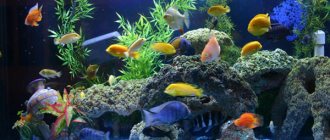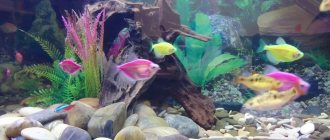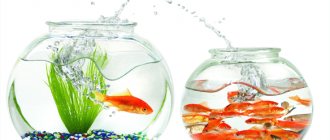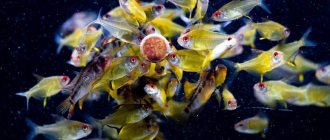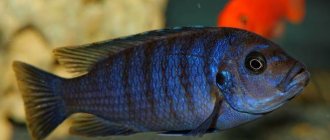Description
The grumbling gourami has a slightly elongated, laterally flattened body, large eyes and a small mouth. The tail fin of the fish is round and wide, pointed in the middle.
The color of the grunting gourami varies from golden to bluish and green. There are 3-4 dark stripes along the body of the fish. The edges of the middle fins have iridescent blue tints. The iris of the eyes is bright: purple or blue.
There are also individuals with purple and blue fins with shades of green or red. Female grunt gouramis are slimmer than males and have a paler coloration.
Main varieties
They differ in species diversity, so you should choose those fish that are suitable for your aquarium. Maintenance and care for all varieties is approximately the same, so their choice is a matter of your taste.
Sumatran
The body is predominantly yellow, with vertical dark stripes. The tail and fins can be colored red (the head of the male acquires the same shade during spawning).
The average size of an individual is 6 cm. Keep in mind that they need to be kept in schools, so if there are less than 6 fish in the aquarium, they will show aggression towards other aquarium inhabitants.
Schubert
It has a lemon color, the fins often turn red. The average length of an individual is 7 cm. This is a peace-loving fish, but it is desirable that other fish be about the same size.
They live for about 7 years (subject to the conditions of detention). They are not picky about food, so you can feed them with dry, live and plant food.
Five stripe
From the name it is already obvious that there are 5 stripes on the body of the fish. They are black and look very beautiful against the background of a reddish body.
The average length of an individual is 5 cm. It gets along well with other aquarium fish of the same size.
Cherry
The brightest representative of this family. It has a rich red color. There is a line on the side.
Denisoni
Individuals are oblong in shape, the body of which is painted silver-golden. A black stripe runs across the side of the body, and above it there is a red stripe, which is located closer to the head.
This species is extremely difficult to find in its natural habitat, so specialists are actively breeding these fish to preserve their population.
Shark barb
The name fully justifies itself - the fins of this fish very much resemble the fins of a shark.
This is one of the largest varieties of this family. The length of some specimens reaches 35 cm, so they need to be housed with fish of approximately the same size.
Fiery
The fish has an elongated body, compressed at the sides. Closer to the tail there is a dark spot surrounded by gold. The body itself is fiery in color, and the back has a greenish tint.
Butterfly
A characteristic feature of this variety is the presence of black spots on the sides of the fish. The color of the body is light brown. Rarely grows to large sizes - about 3-4 cm.
Maintenance and care
Even novice aquarists can handle keeping the grunting gourami. This is a fairly unpretentious fish.
Aquarium
- For one pair of fish, an aquarium measuring 30 by 60 cm is sufficient. However, given the fact that gouramis are grumbling, schooling fish, it is better to keep them in groups. This will require a larger aquarium.
- The aquarium must be kept closed at all times. Do not fill it with water to the very top. Grunting gouramis require constant access to air. To keep it warm at the surface of the water, you need to cover the aquarium. If this is not done, the fish may develop colds.
Water
The optimal water temperature for keeping grumbling gourami is from 22 to 28 degrees Celsius. The water hardness in the aquarium should be – 5 – 19 dGH
It is necessary to provide light aeration with filtration, since grumbling gouramis do not like flow. Even with slight fluctuations in water, they will not build nests. For the same reason, a water change of 10-20 percent is required no more than once every 2 months.
Grunting gouramis are prone to a disease called oodinosis. It is almost impossible to cure, but it develops if the fish are kept in too acidic and soft water.
Scenery
The aquarium where the grumbling gourami lives should have good lighting. These fish are quite shy, so it is necessary to place a sufficient amount of driftwood in the aquarium and take care of dense vegetation that will diffuse light and create a more natural environment.
Plants such as different types of mosses and Thai fern can be attached to driftwood. There should be enough free space for the gourami to swim freely.
Feeding
The grumbling gourami is considered a micropredator. Therefore, in nature it feeds on insects, larvae, and small crustaceans.
- In the aquarium these fish are omnivores. Therefore, almost all types of food are suitable for them: live, frozen, dry. Gourami prefers to take food from the surface of the water, but if necessary, it can feed both at the bottom and in the middle layers.
- Most often, aquarists use dried food to feed grumbling gourami. At the same time, it is important from time to time to add a sufficient amount of live food to the diet of these fish: daphnia, artemia.
Equipment
Barbs love water saturated with oxygen, so you should immediately take care of purchasing the following equipment:
- Filter. Can be external and internal. When choosing, first of all, you should focus on the power of the device. It would be desirable to have additional functions, such as adjusting the flow speed.
- Compressor. Creates the necessary aeration of water, which is important not only for the barbs themselves, but also for the vegetation in the aquarium.
- Thermostat, with which the required temperature is regulated and maintained.
The design of the aquarium can be chosen in the same style as the natural habitat of these fish: South and Southeast Asia, Africa, etc. You can place driftwood, stones, and more living vegetation inside.
When planting plants, you need to think about their location in advance. Barbs are very active, so there is no need to plant everything with vegetation - give them a free area where they can frolic. It is advisable to place large plants in the back space.
Ground and lighting
Coarse quartz sand and sea pebbles can be used as soil. It is advisable to choose a soil of a darker color - this way the barbs will look more impressive.
These fish are unpretentious to the level of lighting, so there are no special requirements here. You can choose the type of lighting that is preferable for the vegetation that you plant in the aquarium.
Reproduction
At the age of 5-6 months, the grunting gourami reaches sexual maturity. For further reproduction of fish, you will need to prepare a spawning tank; its volume should be more than 15 liters.
At the same time, you don’t have to add soil to it. The water level in the spawning tank should be at 10-15 cm.
Part of the water surface should be filled with floating plants (aquatic fern, riccia).
It is these that the male will use to build the nest. The viewing glass should be closed during the spawning period so as not to disturb the fish.
To breed grumbling gourami, it is necessary to take into account that the optimal water parameters should have a pH of 6-7 and a hardness of 4-10. The temperature should be slightly higher than in a general aquarium - 27-30 degrees Celsius.
- It is better to select 2 females and one male as breeders. They should be kept separately before planting in the spawning tank. The male builds a nest on the surface of the water. It consists of just a few bubbles. During the spawning period, the female lays about 75-185 eggs.
- After spawning is completed, it must be transplanted. Next, the male is responsible for raising the offspring. He removes all the dead eggs and returns to their place the larvae that have fallen out of the nest. The incubation period lasts two to three days.
- After another 2 days, the fry begin to swim and feed. At this time, the male should be removed from the spawning tank. Aeration will also need to be improved.
- The water level should be reduced to 5-10 cm until the fry have formed a labyrinth. At first, the fry should be fed with rotifers and ciliates.
What kind of fish to get and how to combine them in small quantities
Aquarium 4-5 liters: it is better to leave without live fish, you can limit yourself to just a beautiful design.
Aquarium 10 liters:
- 1 cockerel;
- 3-4 cardinals
- 4-5 guppies or Endler’s guppies (these are natural individuals, they are even smaller than the ones we are used to, bred by breeders);
- 4-5 neons;
- 4-5 Norman blue-eyes;
- up to 10 microdigestions
It is better not to combine several species in such a tank: the schools will be too small, and the fish will not live happily.
Aquarium 20 liters:
- 1 male cockerel with 2-3 females;
- 12-15 guppies;
- up to 20 zebrafish or neons;
- 5-7 cardinals;
- 10-12 happy neons;
- up to 20 microrasbor.
Can be combined:
- 5 guppies and 5 zebrafish;
- 10 guppies and 2 speckled catfish;
- 7-8 neons and 2 speckled catfish.
30 liter aquarium:
- 4-5 barbs;
- 2-3 apistograms;
- 12-15 cardinals;
- 20-25 neons or zebrafish;
- 2-3 macropods;
- 2-3 Werner's iriaterina;
- 10 analysis
30-40 liters is considered ideal for a beginner. It is convenient to observe the behavior of fish, track diseases and organize feeding.
Possible diseases
If the conditions in the aquarium are close to ideal, then the irises will sparkle with all their colors, which means they are healthy. But as soon as the environmental parameters are significantly violated, the brightness of the color fades.
In addition to maintaining clean cleaning systems, proper aeration and lighting, it is also important to monitor the quality of food, because many infectious diseases are introduced into an artificial reservoir with it.
Before planting in the ground, it is better to disinfect plants by first holding them in a weak solution of potassium permanganate.
New inhabitants should be introduced into the aquarium only after first keeping them in quarantine.
If ulcers and lesions appear on the bodies of rainbow fish, then most likely there are parasites, such as fish louse. In this case, it is necessary to increase the level of aeration and make the water a degree warmer. You should also salt it a little (about a tablespoon per 10 liters).
If “semolina” appears, use a solution of Methylene blue.
If rainbows are provided with good conditions and proper care, they can live in an aquarium for 5-7 years.
How long do fish live in small aquariums?
A pressing question, especially for beginners. Small fish rarely survive beyond the age of 2 years. Just open and read the description of any small fish. It indicates the maximum lifespan in captivity, with proper nutrition, lack of stress and good care. If the conditions are unsuitable, the fish live even shorter. Their condition is negatively affected by:
- Dirty water;
- Overpopulation;
- Wrong food;
- Lack of vital facilities (shelters, living plants, soil, aeration, filter);
- Constant stress;
- Incorrect temperature;
- Infections introduced with dirty equipment or new fish. If someone gets sick in a small aquarium, the infection is likely to spread to all the inhabitants, including catfish.
The smaller the aquarium, the less suitable it is for keeping living creatures. Therefore, nano-aquarium is considered a difficult task. However, small home aquariums of 30 liters are quite suitable for beginners: they can accommodate quite a lot of unpretentious fish, be beautifully decorated and equipped with a filter and compressor. Don’t forget that even a small aquarium requires regular maintenance: cleaning the soil, walls, and water changes.
Breeding
Sexual maturity in melanotenia occurs at 6-9 months. Males are always larger and much brighter than females.
There is nothing complicated about breeding iris. At first they are fed abundantly, giving preference to plant foods. Then the female lays eggs and fertilizes them with the male. As usual, the number of eggs increases with each subsequent spawning.
If the fry need to be preserved, the parents are placed in a special hatchery before spawning, and after spawning and fertilization, the clutches are removed.
The ideal size of the spawning tank is no more than 35 liters. Complies with the following parameters - temperatures +25...+ 28 °C and fairly high hardness (about 10-15 units), the acid-base balance is close to neutral. A filter with a jet is necessary to organize a small flow. Aquatic plants are required - it is on them that eggs will be laid. It is advisable to choose species with small leaves. The water is changed frequently. Thus, reproduction is stimulated, since all these conditions simulate the rainy season.
The female can spawn within three days (usually in the morning).
The eggs are tied into a long thin thread that sticks to the leaves of aquatic plants. There are up to 500 eggs in the clutch; those that turn white and cloudy must be removed.
After one to two weeks, the fry hatch. They usually begin to move and eat food by the end of the first week of life. It is better to choose live dust as starting bait. Then gradually introduce new foods into the diet, giving preference to plant-based types.
Melanothenia grows very slowly. Only towards the end of the second month of life does the initial coloring begin to appear. From the age of six months, iridescents can be considered adults.
